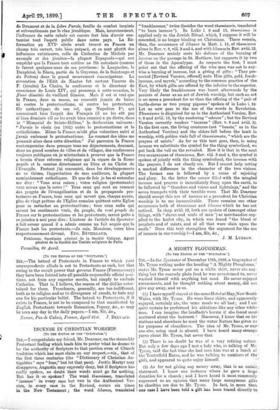INCENSE IN CHRISTIAN WORSHIP.
[To THE EDITOR OE THE "SPECTATOR.']
congratulate my friend, Mr. Dearmer, on the staunchly Protestant feeling which leads him to prefer what he deems to be the authority of Scripture to that portion even of Church tradition which has most claim on our respect,—viz., that of the first three centuries (the "Dictionary of Christian An- tiquities" says "four," but let that pass). Justin Martyr may disapprove, Augustin may expressly deny, but if Scripture has really spoken, no doubt their words must go far nothing. But has it so -spoken The word thumiasna, .translated "incense" in every, case but two in the Authorised Ver- sion, in every case in the Revised, occurs six times in the New Testament ; the word libanos, translated "frankincense," twice (besides the word thumiazein, translated "to burn incense "). In Luke i. 9 and 11, thsmiama is applied only to the Jewish Ritual, which, I suppose it will be conceded, is no longer binding on Christians. There remain, then, the occurrence of libanos in Matt. i. 11, of thumiainct alone in Rev. v. 8, viii. 3 and 4, and with libanos in Rev. xviii. 13. Mr. Demmer mainly rests his defence of the burning of incense on the passage in St. Matthew, but supports it by two of those in the Apocalypse. As respects the first, I must point out that the offering of the wise men was not in any- wise a burning of incense, but a giving of gifts : "They pre- sented [Revised Version, offered] unto Him gifts, gold, frank- incense, and myrrh," according to the common practice of the East, by which gifts are offered by the inferior to the superior. Very likely the frankincense was burnt afterwards by the parents of Jesus as an act of Jewish worship, but such an act is no more a precedent for us than the offering of the "pair of turtle-doves or two young pigeons" spoken of in Luke i.24. Let us now pass to the use of the words in Revelation. Thumiama is disguised for us in the Authorised Version, Rev.
v. 8 and xviii 13, by the rendering " odours" ; but the Revised Version correctly renders " incense " (Rev. v. 8 and xviii 3). In the first case, the living creatures (not "beasts," as in the Authorised Version) and the elders fall before the lamb in worship, with golden vials full of th,umiamata, "which are the prayers of saints." As far as this text goes, then, in using incense we substitute the symbol for the thing symbolised, we put back the veil on the revealed. How it is that in the next two occurrences of thumiama, Rev. viii. 3 and 4, the symbol is spoken of jointly with the thing symbolised, the incense with the prayers, I do not clearly see. But I cannot help noting a marked difference in the character of the two visions. The former one is followed by a scene of rejoicing and glory. In the latter the censer filled with the mingled incense and prayers is immediately flung upon the earth, to be followed by "thunders and voices and lightnings," and the seven trumpets with their terrible woes. That Mr. Dearmer should accept this use of incense as a precedent for Christian worship is to me inconceivable. There remains one other occurrence both of thumiama and libanos which he has not noticed. In chap. xviii. 13, both are spoken of (amongst other things, with "slaves and souls of men ") as merchandise sup- plied to the harlot city, in which was found "the blood of prophets and of saints, and of all that were slain upon the earth." Does this text strengthen the argument for the use of incense in our worship ?—I am, Sir, &c., J. M. LUDLOW.






















































 Previous page
Previous page